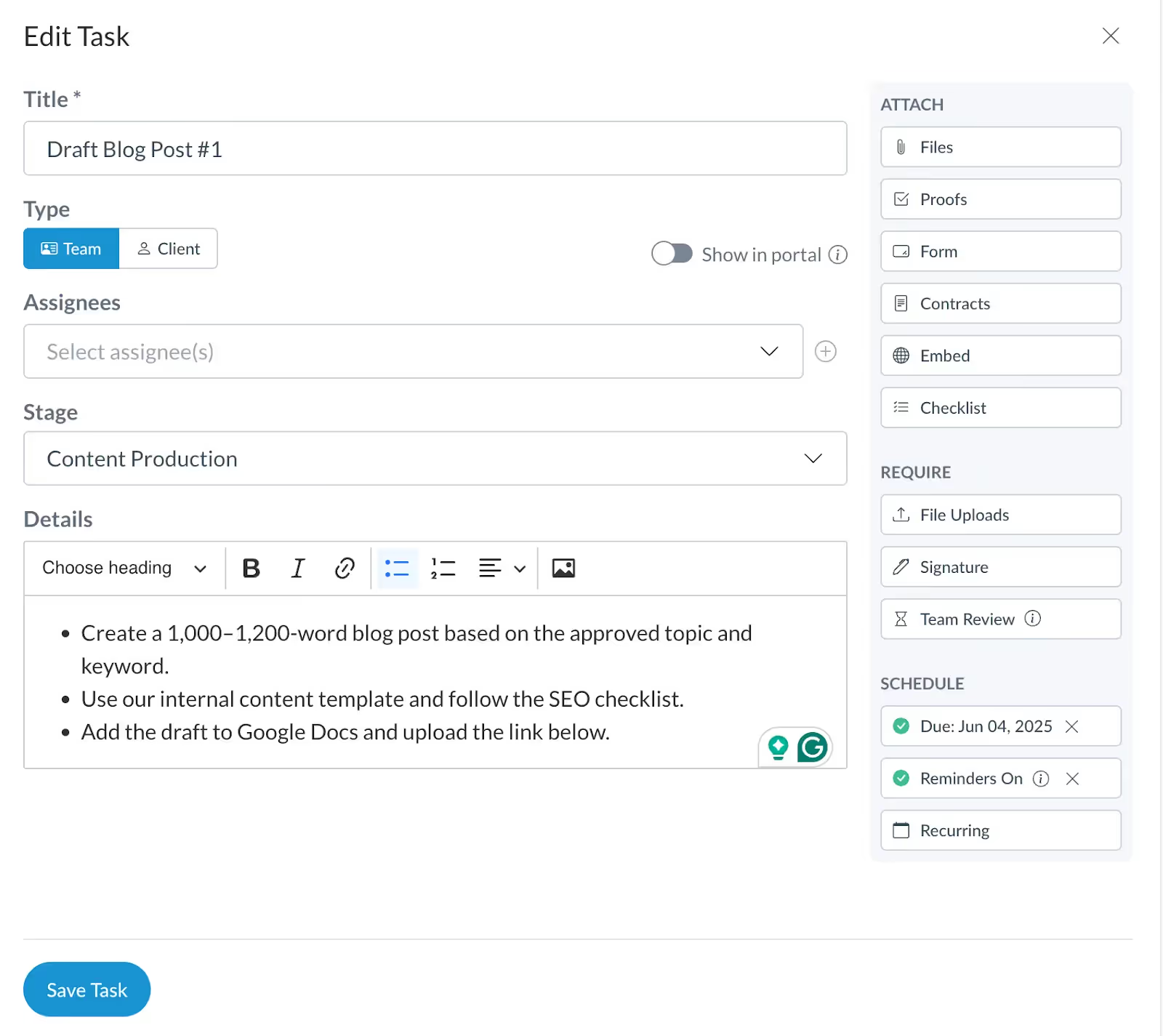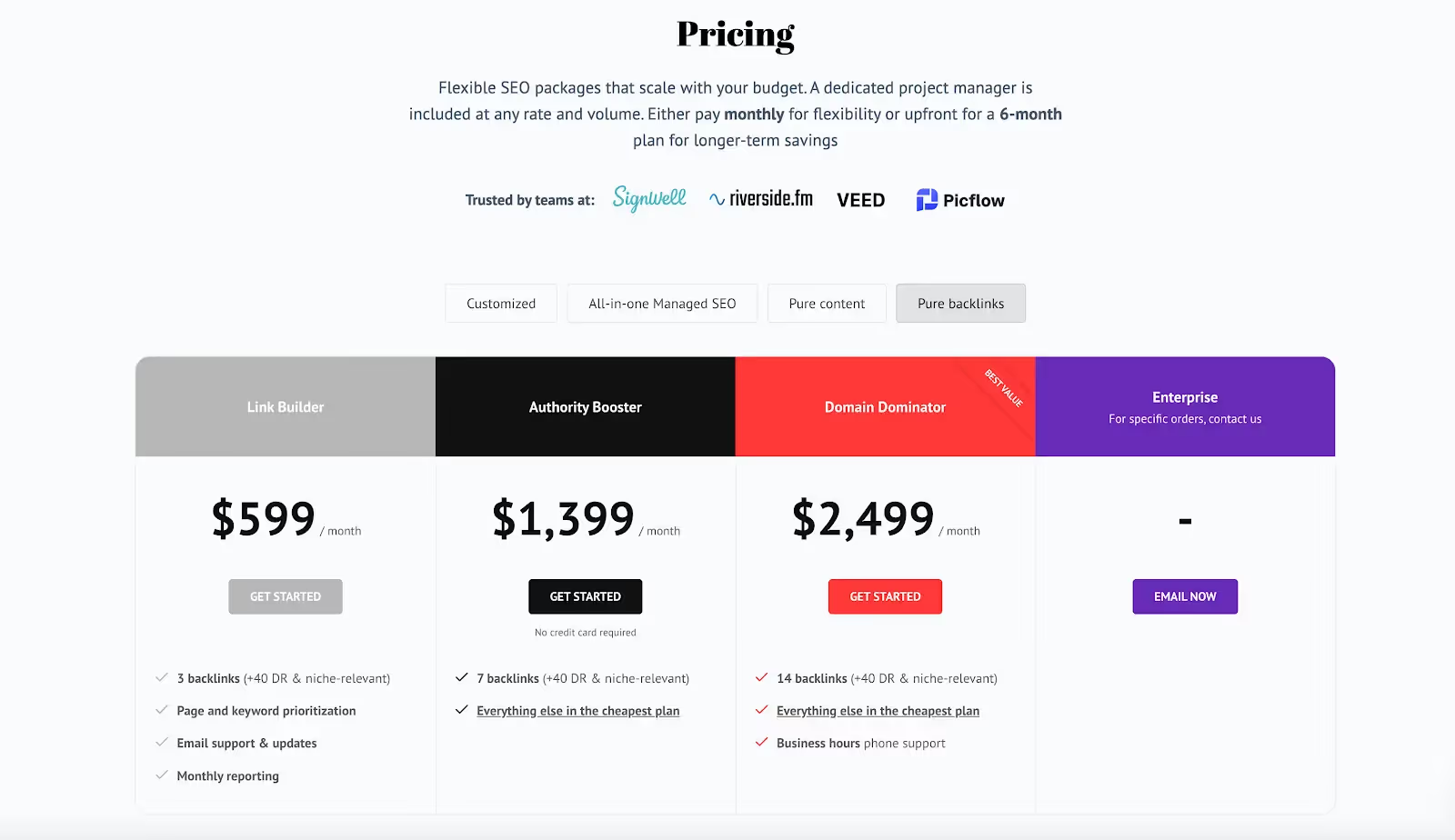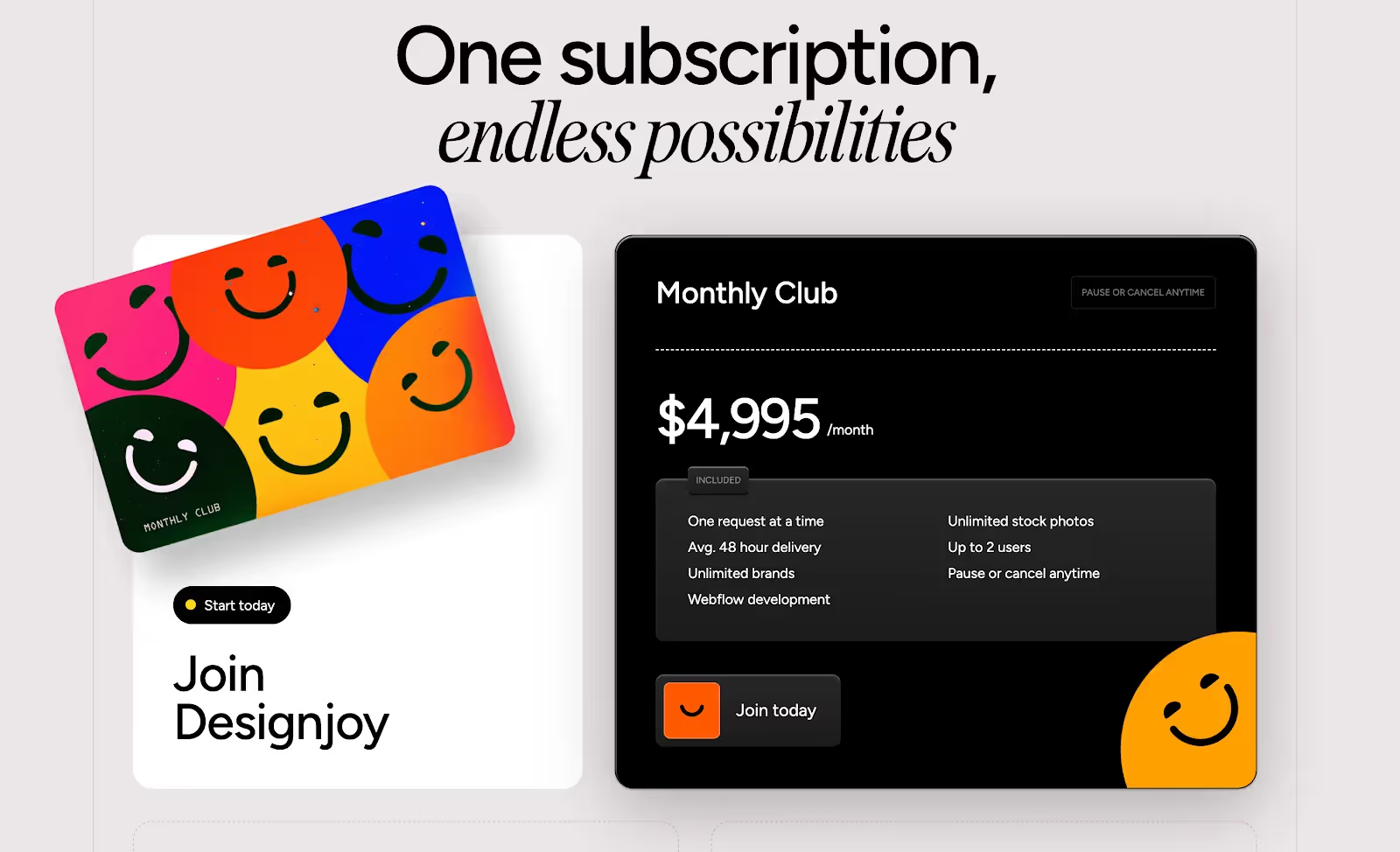Jun 5, 2025
How to Turn Your Agency Into a Productized Service
By
Perry
.avif)
I built a productized agency service before (Brighter Vision). It wasn’t easy, but it changed everything for my business.
Like most agency owners, I started out with custom proposals, unpredictable pricing, and too many back-and-forth emails. I was busy—but my agency wasn’t truly growing.
Switching to a productized model gave me clarity and control. Clients understood what they were getting, and I could deliver with less stress and better margins. The path wasn’t always straightforward, but the results were worth it.
If you’re tired of scope creep, chaos, and inconsistent revenue, you’re in the right place. In this guide, I’ll show you exactly how to productize your agency services. I’ll share what I learned, what I’d do differently, and the tools that made it possible.
What Is a Productized Service?
A productized service is a standardized offering that’s sold like a product. It has a fixed scope, clear deliverables, and set pricing. Clients know exactly what they’re getting, and you know exactly what you’re providing.
Instead of writing custom proposals for every new client, you offer the same service in the same way each time.
Examples of productized services in a digital marketing agency might include:
- A one-time SEO audit with a report and checklist
- A monthly blog content package (e.g. 4 posts/month)
- A paid ads setup service with campaign launch included
- A branded social media content bundle
We’ll go through specific examples later. For now, just think of it as turning your most repeatable service into a simple, ready-to-buy offer.
Why Productize Your Agency Services?
If you’ve spent time in agency communities or marketing Slack groups, you’ve probably seen success stories that made you wonder: Should I package my services too?
Take Jake Hundley, co-founder of Evergrow Marketing. He shared on Reddit how his agency offers a productized SEO and PPC service for $750/month - and brought in $400k in revenue in a single year. No custom proposals. No massive team. Just tight delivery systems and clear service packages.
Stories like this are turning heads. Here's why productized services could work for you too.
Turn interest into action
One of the biggest challenges for agencies is converting curious leads into paying clients, especially when pricing is vague and deliverables are up for negotiation.
A productized service removes that friction. When someone visits your site or hears about your offer, they know exactly what it is, how much it costs, and what to expect. That clarity builds trust and makes it easier for prospects to say yes without the back-and-forth.
Easier to scale without more headcount
When your services follow a consistent structure, you can hand off work more easily to contractors or junior team members. You don’t need to explain the process every time or manage unpredictable timelines.
This kind of repeatability makes it possible to grow revenue without growing your team (or your stress levels).
Better profit margins and fewer scope issues
Scope creep is a major profit killer in traditional agency models. Productized services eliminate that by locking in what’s included and what’s not. You can price based on the true cost of delivery and track profitability much more easily. That makes it clearer how to scale without sacrificing quality or margins.
Easier to market and sell online
Productized services are easier to explain on your website or landing page. You can give your service a name, list what’s included, and even let people buy or book online.
That opens the door to running ads, growing an email list, or even getting discovered on marketplaces without needing to pitch every time.
How to Productize Your Services
In the steps below, I’ll walk through how to productize a service into a streamlined, scalable offer using Motion.io.
Motion.io is a client onboarding and engagement platform that helps agencies collect information, deliver work, and stay organized through branded, loginless portals.
It’s an excellent fit for productized services because it simplifies how you work with clients. A great addition to create a more consistent client experience—which is probably one of your goals if you’re looking to productize in the first place.
Step 1: Identify the right service to productize
Start by choosing one service your agency already offers; ideally something clients ask for often, that follows a consistent process, and delivers a clear outcome.
The best services to productize usually meet three criteria:
- You’ve done them multiple times with success
- You already have a rough process in place
- They don’t require a ton of custom strategy or one-off decisions
For most digital marketing agencies, common candidates include things like:
- SEO audits
- Google Ads campaign setup
- Blog content packages
- Social media calendars
- Monthly reporting and analytics reviews
Start with just one. You can always expand your offerings later, but focusing on a single service makes it easier to build a repeatable system.
🔧 In Motion.io:
Once you’ve picked your service, you can use Motion.io to gauge interest before you fully commit.
For example, you can set up a simple form inside a branded portal and and ask past or existing clients if they’d find a fixed-price version of your service useful. It’s a quick way to validate your idea and build momentum before launch.
Step 2: Define the scope and deliverables
Now that you’ve chosen the service to productize, it’s time to get specific about what you’ll include.
Productized services only work when the scope is clear. That means spelling out exactly what the client will receive, how it will be delivered, and what’s not included. Without this, you’re still in custom-service territory.
Here are a few questions to help you shape your offer:
- What’s the outcome the client will walk away with?
- How long will it take to deliver?
- What do you need from the client to get started?
- What’s off-limits or available only as an add-on?
Keep it tight. The goal isn’t to impress with everything you could do. it’s to deliver something valuable consistantly.
For example:
Instead of: “We’ll handle your content marketing.”
Try: “You’ll get four SEO blog posts per month (1,000–1,200 words each), including topic research, keyword recommendations, metadata, and internal linking.”
🔧 In Motion.io:
Once your offer is finalized, you can outline the scope in a client portal welcome message, then break the deliverables into tasks or milestones.

Unlike sending this info over email—where things get lost or forgotten—everything stays in one place. Clients always know what’s next, and you avoid chasing down questions or repeating yourself.
Step 3: Set your pricing and plan for profitability
Pricing your productized service is about making sure you’re profitable, yet easy to say yes to.
Whether you’re offering a one-time service or a monthly subscription, your pricing needs to be:
- Clear (no vague ranges or “contact us”)
- Sustainable (covers delivery + leaves a healthy margin)
- Aligned with the value your service brings to clients
Here are some tips to help you build the ideal pricing model:
Start with cost-backwards pricing
Figure out what it actually costs to deliver the service. This includes your time, your team, tools, and even revision rounds.
Ask yourself:
- How many hours does it take, from start to finish?
- What tools are required, and what do they cost per client?
- Are you delivering it yourself or delegating?
Set your price based on real delivery costs and aim for at least a 50–70% margin so the offer stays sustainable as you scale.
Choose a pricing model that fits the service
Now that you have a baseline cost, choose the pricing structure that makes the most sense. This depends on what you’re delivering and how often:
You don’t need three packages right away. Start with one, and expand later if you spot a demand for upgrades or add-ons.
Don’t price too low (even if you’re just starting)
It’s tempting to offer low prices to attract early clients. But low pricing often brings high-maintenance clients with tight budgets, which can lead to burnout and razor-thin margins.
Instead:
- Keep the scope tight
- Bake in time for communication and revisions
- Use client testimonials and past results to build trust
🔧 In Motion.io:
Once your packages and pricing are set, Motion.io makes it easy to guide clients through their options during onboarding. You can let clients select a package in a form, then trigger the right task list and client portal experience automatically.
This removes the need for multiple emails. Clients see only what’s relevant to them, and you don’t have to manually set up each project from scratch.
It’s how productized services stay productized—without turning into custom work behind the scenes.
Step 4: Standardize your workflow
Now it’s time to make your delivery process repeatable. This is where your professional services stop being a “one-off” and start becoming a true product.
The goal here isn’t to automate everything. It’s to make sure you (or anyone on your team) can deliver the same level of quality every time.
Start by mapping out the process
Think through your delivery. What happens first, what happens next, and what’s the final handoff?
Here's an example for a blog content package:
- Receive topic approvals
- Write draft 1
- Internal review
- Send for client feedback
- Revise and finalize
- Upload to CMS or deliver doc
Even if it seems basic, documenting these steps gives you the foundation for delegation, automation, and scale.
Then turn it into a reusable template
Once your steps are mapped, create a reusable system.
You can build your workflow as a reusable project template inside Motion.io. Each task can include:
- Deadlines
- Descriptions
- Internal or client-facing instructions
- Attached docs, links, or forms

That way, every time a new client comes on board, you're not starting from scratch. You’re launching a pre-built process with consistent steps and outcomes.
No need to manage a separate checklist in Notion or ClickUp. Everything lives inside the same portal where your client is already working.
Step 5: Set up a consistent client experience
Delivering a productized service isn’t just about what you do. It’s about what your client sees and how easy it is for them to work with you.
From the moment a client signs up, they should know exactly what to do next.
Instead of sending a long email or juggling a kickoff call for every project, make onboarding self-serve. Create a repeatable flow where clients can:
- Fill out a quick form
- Upload files or brand assets
- See what to expect over the next few days or weeks
And every stage after onboarding should follow the same principle: clear steps and one place for everything.
Motion.io makes that easy. Each client gets their own branded, loginless portal where they can:
- Submit onboarding info
- Upload and download files
- Approve deliverables
- Track progress, all in one place
Step 6: Launch, test, and improve
You don’t need everything perfect before you launch. In fact, trying to build the “final version” of your productized service behind the scenes can slow you down for months.
The better approach? Launch a clean, minimum version, then improve it based on what clients actually want.
Start with a pilot version
Pick one client (or a small group) and offer your service in its new, productized format. You can even position it as a “beta version” or early access offer.
Keep things simple:
- Use your new scope and pricing
- Deliver it using your standardized workflow and client portal
- Track how long it takes, where clients get stuck, and what questions come up
Gather feedback that actually helps
Instead of asking, “Did you like the service?”, ask:
- Was anything unclear about the deliverables?
- Did the timeline match your expectations?
- Was anything missing from the onboarding?
- Would you recommend this package to someone else?
These questions help you spot gaps in the experience and tweak your process without throwing everything out.
🔧 In Motion.io:
Motion.io makes it easier to improve over time because you can actually see:
- Which tasks get delayed
- Which forms are incomplete
- Where clients tend to ask the same questions
This gives you real feedback so you can adjust your templates, tighten up your onboarding, or improve how you explain your service.
Real Examples of Productized Services for Agencies
If you're looking to productize your agency services, it helps to see how others are doing it successfully.
The four agencies below offer clear, standardized service packages with public pricing. They’re great models for what a productized service should look like.
Embarque – SEO blog content packages

Embarque provides blog content and link-building services tailored for fast-growing startups and SaaS companies.
Why it’s a strong productized example:
- Transparent, tiered pricing: Each plan comes with a fixed monthly fee, so clients always know what they’ll pay—no proposals, hourly rates, or hidden extras.
- Standardized deliverables: Every package lists exactly what’s included, like the number of articles or backlinks, plus extras such as keyword research and reporting, so there’s no ambiguity.
- Self-serve experience: Prospective clients can easily compare plans and sign up online without the usual sales calls or negotiation, making it truly on-demand.
Content Cucumber – Subscription-based content writing

Content Cucumber offers businesses an easy way to outsource content writing with a flat monthly subscription.
Why it’s a great productized example:
- Simple, subscription-based pricing: Clients know exactly what they’ll pay each month, with no surprise fees or add-ons.
- Clear deliverables and workflow: Each plan spells out what you get—dedicated writer, set word count, unlimited requests and revisions—so expectations are always clear.
- Self-serve and repeatable: Anyone can sign up online and immediately start submitting content requests in a managed queue, making content creation as easy and reliable as ordering a product.
ManyPixels – Unlimited graphic design

ManyPixels provides graphic, web, and motion design services on a subscription basis.
Why it’s a great productized example:
- Set-it-and-forget-it pricing: Clients pay a predictable flat monthly fee with no hidden charges, making budgeting simple.
- Standardized process: Work is managed through a clear design queue, with guaranteed turnaround and status updates, so there’s no confusion about what’s happening next.
- Transparent, tiered packages: Every plan has clearly listed inclusions (from graphic to motion to web design), so clients know exactly what’s covered before they buy.
- No custom quoting or proposals: Anyone can sign up instantly and start submitting design requests—turning design work into a repeatable, on-demand service.
DesignJoy – Unlimited design club subscription

DesignJoy is a one-person creative studio delivering unlimited design tasks for a flat monthly fee.
Why it’s a strong productized example:
- Predictable, flat pricing: Clients always know what they’ll pay.
- Clear scope and process: Unlimited design requests are managed in a queue (one at a time), with published turnaround times and no surprises about how it works.
- Self-serve and flexible: Clients can pause or cancel anytime, treating design as a true subscription service—just like software.
- Transparent deliverables: Everything included (Webflow, brands, users, stock photos) is listed upfront, so there’s zero ambiguity for clients or the agency.
Recommended Tools for Productized Agencies
Running a productized agency is much easier with the right tech stack.
Motion.io
All-in-one client portal for productized services
Motion.io gives you a single, branded space to manage the entire client experience. You can collect information, share files, and show progress all in one place. No need for separate tools.
On the client side, there’s no login or email searching—they just use a simple, self-serve portal. This saves you time on admin and helps you deliver your services in a more professional, productized way.
Stripe
Payments & subscriptions
Set up recurring billing, manage one-off payments, and automate invoicing so you can get paid without friction.
Zapier
Workflow automation
Connect Motion.io and your other apps to automate onboarding, payment triggers, reporting, and more.
Other tools to consider
Depending on your agency’s workflow, you might also want:
- DocuSign or HelloSign for contracts and digital signatures
- Google Analytics or Looker Studio for in-depth reporting and dashboards
- Canva or Figma for hands-on design collaboration (if you create visual content for clients)
- Loom for quick video walkthroughs or project updates
- Calendly for booking calls if your process includes client meetings
Common Mistakes to Avoid When Productizing Your Agency Services
I’ve learned the hard way that even small missteps can derail a productized service before it gets off the ground.
In this section, I’m sharing the biggest mistakes I’ve seen so you can avoid the same pitfalls and keep your agency running smoothly.
Not building in limits (unlimited = burnout)
Agencies often offer “unlimited” requests without clear boundaries on what counts as a single request or what turnaround times clients should expect. This leads to client abuse, burnout, and dissatisfied customers when expectations aren’t managed.
Solution: Spell out what’s included, how many requests are handled at once, and how long delivery takes.
Ignoring client education
Many agencies launch productized services but forget to clearly explain to clients how the process works—resulting in confusion and support headaches.
Solution: Include FAQs, welcome videos, or onboarding checklists to educate clients up front.
Underestimating support needs
Some agency founders assume productized services will be “set and forget,” but you still need to handle questions, small issues, and client communications.
Solution: Build support time into your pricing and workflow.
Overlooking brand positioning
A generic “monthly service” can get lost in the crowd. Failing to give your productized service a distinct name, value prop, or angle makes it hard to market.
Solution: Name your packages, highlight your unique process, and make your offer memorable.
Frequently Asked Questions (FAQs)
Can I still offer custom work alongside productized services?
Yes, many agencies adopt a hybrid model. They maintain standardized packages for efficiency and scalability while accommodating custom projects for clients with unique needs. This approach allows you to serve a broader client base without compromising operational efficiency.
What if clients request services outside the package scope?
Clearly define the scope of your services in your package descriptions. For additional requests, offer them as separate add-ons or custom projects. This approach maintains the integrity of your productized service model while accommodating client needs.
Do I need a complex tech stack to manage productized services?
Not necessarily. Many agencies operate efficiently with a streamlined set of tools. For instance, Motion.io can handle client onboarding, communication, and project tracking in one platform, reducing the need for multiple apps.
Is it possible to scale a productized service business?
Absolutely. Productized services are built to scale. By optimizing processes and taking advantage of automation, you’ll be able to take on more clients without needing to hire a big team.
You’ve Got This: Launch Your Productized Service Today
If you’re ready to escape the chaos of custom work and create a more scalable, stress-free agency, now’s the time to make your move.
And remember: you don’t have to manage every step manually.
Smart automation platforms like Motion.io can take care of the details—handling client onboarding, sharing files, tracking progress, and keeping projects organized in one place. That means less admin for you, and a smoother experience for every client.
Ready to put productization into action? Sign up for a free Motion.io trial and see how easy it can be to run a more efficient, profitable agency.


Scale your onboarding, not your overhead
Motion.io gives you the workflows, visibility, and automation to take on more clients--without the chaos.
